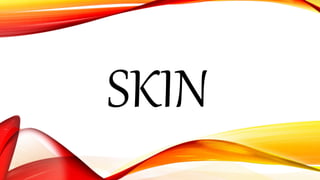
Structure of Skin.fxtxrxtcyftftfyfyfftfpptx
- 1. SKIN
- 2. SKIN • The skin is the largest organ in the body and has a surface area of about 1.5–2 m sq. in adults. • In certain areas, it contains accessory structures: glands, hair and nails. • It is not uniformly thick. At some places it is thick and at some places it is thin. • The average thickness of the skin is about 1 to 2 mm. • In the sole of the foot and palm of the hand, it is considerably thick, measuring about 5 mm. In other areas of the body, the skin is thin. • It is thinnest over eyelids and penis, measuring about 0.5 mm only.
- 3. STRUCTURE OF SKIN The skin consist of 2 main layers: Epidermis (superficial layer) Dermis (inner layer)
- 4. EPIDERMIS The epidermis is not supplied by the blood vessels and receives nutrition from lymph. Epidermis is subdivided into following layers: Stratum corneum Stratum lucidum Stratum granulosum Stratum spinosum Stratum germinativum.
- 5. Stratum corneum: It is the most superficial layer. It has scale like horny keratinized non-nucleated cells which are stratified epithelial. These cells gradually cast off Amongst the keratin present are free amino acids which by acting as buffer serve to protect the skin from action of mild acids and alkalis.
- 6. Stratum lucidum: • Stratum lucidum is made up of flattened epithelial cells. • It is thin and transparent layer made of indistinct non- nucleated cells. Stratum granulosum: • It is made up of two or three layers. • The cells are may be spindle shaped, triangular or rhomboid, but all cells have granules which stain deeply. • The granules have eleidin and kerato-hyaline which changes to keratin in stratum lucidum.
- 7. Stratum Spinosum • Stratum spinosum is also known as prickle cell layer because, the cells of this layer possess some spine- like protoplasmic projections. • By these projections, the cells are connected to one another.
- 8. Stratum germinativum: • Stratum germinativum is a thick layer made up of polygonal cells, superficially and columnar or cuboidal epithelial cells in the deeper parts. • Here, new cells are constantly formed by mitotic division. The newly formed cells move continuously towards the stratum corneum. • The stem cells, which give rise to new cells, are known as keratinocytes. • Another type of cells called melanocytes are scattered between the keratinocytes. • Melanocytes produce the pigment called melanin. The color of the skin depends upon melanin. • From this layer, some projections called rete ridges extend down up to dermis. These projections provide anchoring and nutritional function.
- 9. DERMIS It is made of loose connective tissue along with blood vessels, lymph, nerve fibre etc. Adjacent to basal layer of epidermis and projecting into it are papillae of skin. The dermis also have tubular glands such as sweat and sebaceous gland and hair follicle which represent the down-growth from epidermis into dermis and subcutaneous tissue. Attached to hair follicle is erector pilorum, the contraction of which makes the hair stand on end. Dermis is made up of two layers: Superficial papillary layer Deeper reticular layer
- 11. Superficial Papillary Layer • Superficial papillary layer projects into the epidermis. • It contains blood vessels, lymphatics and nerve fibers. • This layer also has some pigment containing cells known as chromatophores. • Dermal papillae are fingerlike projections, arising from the superficial papillary dermis. • Each papilla contains a plexus of capillaries and lymphatics, which are oriented perpendicular to the skin surface. • The papillae are surrounded by rete ridges, extending from the epidermis.
- 12. Reticular Layer • Reticular layer is made up of reticular and elastic fibers. • These fibers are found around the hair bulbs, sweat glands and sebaceous glands. • The reticular layer also contains mast cells, nerve endings, lymphatics, epidermal appendages and fibroblasts.
- 13. THANK YOU
Editor's Notes
- Rupture of elastic fibres occurs when the skin is overstretched, resulting in permanent striae, or stretch marks, that may be found in pregnancy and obesity.